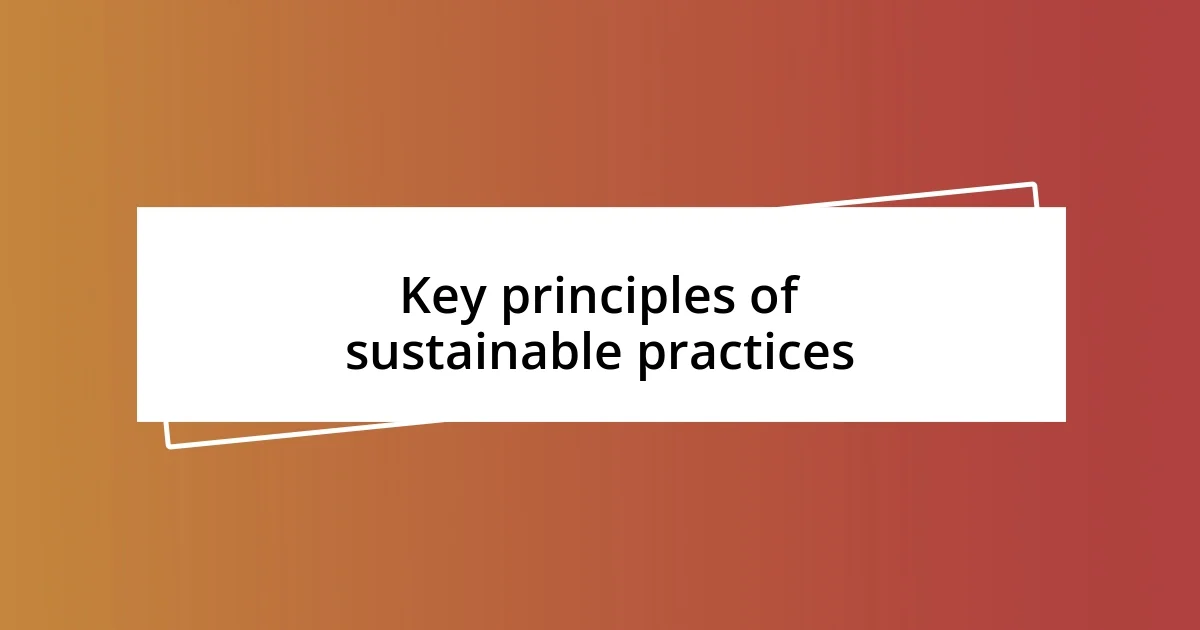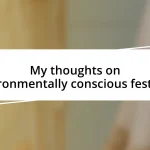Key takeaways:
- Sustainable aquatic projects integrate environmental conservation with community livelihood through innovative practices like aquaponics, fostering biodiversity and resource efficiency.
- The shift to sustainable aquaculture enhances fish stocks and community resilience, emphasizing collaboration among local stakeholders for economic and environmental benefits.
- Future trends in sustainable aquatic initiatives will leverage technology, such as data analytics and aquaponics, to improve resource management and promote biodiversity conservation.

Understanding sustainable aquatic projects
Sustainable aquatic projects focus on balancing human needs with environmental conservation. I remember visiting a community-driven aquaponics farm, where the locals transformed their resource management approach. It was incredible to see how they integrated fish farming with vegetable cultivation, turning waste into nourishment and creating a closed-loop system.
What strikes me most about these projects is their potential for innovation while maintaining harmony with nature. Have you ever wondered how communities can thrive without depleting their surroundings? Through methods like rainwater harvesting or water-efficient aquaculture, these solutions not only sustain local livelihoods but also foster biodiversity.
At the heart of sustainable aquatic initiatives lies the responsibility of stewardship. Personally, I felt a deep sense of connection to the water after seeing how it nurtured both plants and animals. It makes me think: when we treat our waterways thoughtfully, we’re really investing in our future—a future where our children can enjoy the same natural beauty and resources that we do today.

Importance of sustainability in aquaculture
Sustainability in aquaculture is crucial for preserving fish stocks and maintaining ecosystems. I had the opportunity to speak with a local commercial fisherman who transitioned to sustainable practices. He shared how this shift not only improved the health of his catch but also strengthened his connection to the sea—something I found deeply inspiring.
The long-term benefits of sustainable aquaculture extend beyond just the environment. When I visited a coastal community engaged in sustainable fish farming, I witnessed firsthand the economic boost as locals began collaborating and sharing resources. This sense of unity over common goals reminded me that sustainability isn’t just about preserving nature; it’s also about fostering communities and creating resilient livelihoods.
I believe that sustainable practices in aquaculture can act as a catalyst for positive change. During a recent workshop, I learned about innovative technologies that minimize waste and improve efficiency, like recirculating aquaculture systems. Seeing the excitement and hope in participants’ eyes reinforced my conviction that by working together and being mindful of our environmental impact, we can create aquaculture systems that are not only productive but also regenerative for future generations.
| Aspect | Sustainable Aquaculture |
|---|---|
| Environmental Impact | Minimizes depletion of natural resources, promotes biodiversity |
| Economic Benefit | Supports local economies through responsible fishing practices |
| Community Engagement | Encourages collaboration among local stakeholders |

Key principles of sustainable practices
Sustainable practices hinge on several key principles that drive success in aquatic projects. I recall attending a seminar on responsible fishing, where experts emphasized the importance of minimizing waste and ensuring the efficient use of resources. This resonates deeply with my own experiences; I’ve seen firsthand how small changes in management techniques can have a positive ripple effect on the entire ecosystem.
Here are some core principles to consider:
- Resource Efficiency: Utilize resources optimally to minimize waste.
- Biodiversity: Foster diverse ecosystems to enhance resilience and adaptability.
- Community Involvement: Engage local communities in decision-making for long-lasting impact.
- Long-term Planning: Focus on sustainability over quick profits to ensure generational benefits.
- Education and Awareness: Teach sustainable practices and their significance to empower action.
When it comes to the implementation of sustainable practices, I often think about the time I volunteered at a community marine reserve. Witnessing the joy of children learning about marine biodiversity made me appreciate the value of education. What struck me most was how that knowledge inspired collective action, reinforcing my belief that education is vital for the future health of our aquatic environments.

Examples of successful aquatic initiatives
One outstanding example of a successful aquatic initiative is the use of integrated multi-trophic aquaculture (IMTA). In this system, different species are cultivated together, creating a symbiotic environment where waste from one species provides nutrients for another. I remember watching a documentary about an IMTA project in Canada, where shellfish, seaweeds, and fish thrived together. The results were astonishing—not only were the yields higher, but the ecosystem remained healthier and more balanced. Isn’t it fascinating how nature knows best when we let it work together?
Another inspiring initiative is the Mangrove Restoration Project in Indonesia. This project focuses on rehabilitating coastal mangrove forests, which are critical for protecting shorelines and supporting marine biodiversity. Last year, I participated in a local planting event and was struck by the sense of hope in the community. We weren’t just planting trees; we were restoring the very foundation of our coastal ecosystem. The joy in everyone’s faces as they dug into the earth reminded me that sustainable efforts can rally communities towards a shared vision.
Lastly, the Fish Forever project stands out in my mind as a transformative approach to community-led fisheries management. It emphasizes local governance, enabling fishermen to control their resources sustainably. I spoke with a fisherman in the Philippines who explained how adopting these practices not only improved fish stocks but also provided a greater sense of ownership over their livelihoods. When I saw the pride in his eyes, it became clear to me how empowering communities leads to sustainable solutions. How could we ever underestimate the strength of collective responsibility in safeguarding our aquatic treasures?

Challenges in implementing sustainable projects
Implementing sustainable aquatic projects is often hampered by financial constraints. In my journey through various initiatives, I’ve seen organizations struggle to secure funding, which can stall promising ideas. It makes you wonder: how can we expect to achieve sustainability when those with the knowledge and passion are often held back by lack of resources?
Moreover, there’s the challenge of changing mindsets within local communities. One time, I attended a workshop where many fishermen were skeptical about adopting sustainable practices. They worried that these methods might reduce their immediate income. Reflecting on that moment, I realize how crucial it is to communicate long-term benefits clearly. After all, if we can’t help them see the value in sustainability today for a better tomorrow, how can we expect them to invest in it?
Then there’s the intricate regulatory landscape that can either support or hinder these efforts. During a project in a coastal town, we faced numerous permits and regulations that slowed down our progress. It left me pondering: should we be simplifying these regulations instead of complicating them? When sustainability relies on navigating a maze of red tape, it risks being sidelined in favor of more immediate, less eco-friendly choices.

Strategies for community involvement
Community involvement is vital for the success of sustainable aquatic projects, and one effective strategy is educational outreach. I recall an event where local schools participated in a fish tagging program. The delight and curiosity on the children’s faces as they learned about marine life made me realize that fostering awareness early on can create a generation that values and protects our aquatic resources. Isn’t it fascinating how education can transform future stewards of the environment?
Another powerful strategy is encouraging local participation through hands-on initiatives. I once joined a group working to clean up a local river, and as we pulled out trash and debris, the sense of camaraderie was tangible. Seeing neighbors come together for a common purpose not only promoted a healthier ecosystem but also strengthened community bonds. This experience made me ask: what if we could leverage this collective spirit more often in our projects?
Collaboration with local leaders and organizations is another key approach. I remember a successful partnership between a fishing cooperative and an environmental NGO that organized regular forums to discuss sustainable methods. The open dialogue allowed everyone to express concerns and ideas, resulting in tailored solutions that considered local needs. It struck me that when communities feel heard and empowered in decision-making, they’re more likely to commit to sustainable practices. Isn’t that the essence of true community engagement?

Future trends in sustainable aquatics
The future of sustainable aquatics is set to embrace technology in exciting ways. I’ve seen first-hand how innovations like remote sensing and data analytics are reshaping our understanding of aquatic ecosystems. For instance, during a recent project, the use of drones to monitor water quality provided invaluable insights that traditional methods simply couldn’t match. Isn’t it amazing to think how technology can enhance our efforts toward sustainability?
Another promising trend is the rise of aquaponics and integrated multi-trophic aquaculture (IMTA). These systems, combining aquaculture and agriculture, create a symbiotic environment that promotes resource efficiency. I participated in a small-scale aquaponics setup where growing fish and vegetables together not only reduced waste but also maximized yields. It sparked a realization in me: could this innovative approach be the key to feeding our growing population sustainably?
Moreover, the increasing emphasis on biodiversity conservation within aquatic projects is something I find truly inspiring. I remember visiting a coastal restoration site where various native species were reintroduced. The collective excitement among the community members made me reflect on the deeper connection we share with our environment. Aren’t we all part of a larger ecosystem? Fostering this connection will be essential as we move forward in our sustainable journey.














